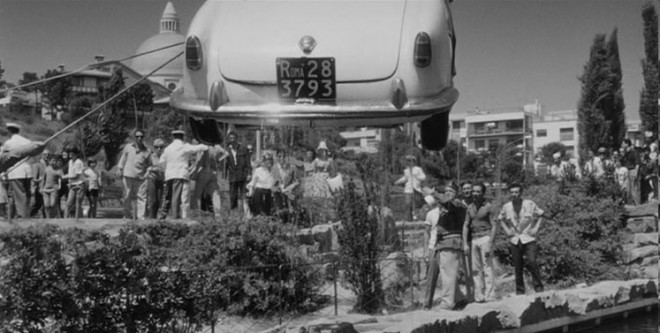The first postwar Hungarian film, Somewhere in Europe . . . (Valahol Európában . . .), set in the mid-1940s, is about children who, orphaned or otherwise dispossessed or discarded by the war, band together and hunt for food in order to survive. This requires vandalizing and theft. A remote ruined castle, the adopted domain of a distinguished musician whose career the war has put on hold, becomes their hiding place as the composer and conductor reeducates them, introducing them to socialistic ideas and classical music, and reversing what seemed their inevitable slide into Lord of the Flies. Locals have been instructed to shoot to kill roaming looters, and suspicious authorities raid the castle, killing one of the boys as the others defend their fortress with cascades of boulders and rocks down the hillside—a possible allusion to Laurence Olivier’s Henry V (1944). Without doubt, however, scenarists Béla Balázs and (also director) Géza Radványi have another film in mind, for which theirs provides a fitting variant: Nikolai Ekk’s The Road to Life (Putyovka v zhizn, 1931), a similar piece of Communist propaganda, this one about the reeducation of wild Russian boys.
The first part of the film shows the boys and two girls coming together into a more or less cohesive group headed by the older Péter Hosszú (Miklós Gábor, charismatic, sensitive), who has been tossed out of reform school. Early on, there are numerous striking images, including angled ones underscoring the children’s uprooted lives in a war-unbalanced world, and ones leaning on symbols of shattered innocence. In both composition and editing, these recall Soviet cinema, both silent and early sound. There is a grotesque sequence showing a child fixed in terror as he witnesses wax figures melting amidst flames, including one of Adolf Hitler. This passage harkens back to the expressionism of silent German cinema. A later flashback, while out of sequence, also belongs to this part of the film. A girl recounts her rape by a German officer, after which, from her apartment’s upstairs window, she sees her entire family being carted away. She returns to the bedroom, and shoots and kills the officer with his own pistol. During the rape, the officer appears as a monstrous shadow; when he is killed, it is again his shadow that we see—and in a scene of death that recalls the death of the vampire in F. W. Murnau’s Nosferatu (1922). Here again Radványi proves himself a student of silent German expressionism.
The second part of the film, with its interaction between the children and the old man, Péter Simon, is enormously effective as a tearjerker, culminating in the death of little Kuksi, who has learned to play “La Marseillaise” on his harmonica. Simon has taught the children “La Marseillaise” as an expression of freedom—what, Simon tells them, they must strive for and fight for. A good deal of this part of the film is reminiscent of Hollywood’s Boys Town (Norman Taurog, 1938).
Both Georges Sadoul and the critical team of Garbicz and Klinowski find the first part of the film excellent and the second part unrealistic and glib. I disagree. I find both parts equally flawed. The first misappropriates German expressionism; the second indulges in Hollywood sentimentality. However, the film’s strongest aspect occurs in the second part, and this is its propaganda. When young Hosszú disparages “freedom” based on his experience of struggling to survive on the open road, Simon convincingly notes that that wasn’t freedom at all. “Poverty,” he tells the youth, “is the worst form of captivity”—not only a message in favor of the current new order (at the time of the film rather than at the time in which the action is set), but a sharp rebuke of capitalism, which generates poverty as a matter of course while touting freedom. That there would be little or no freedom in the new Hungary for those disputing the Party line is conveniently excluded by the fact that Simon is scarcely a prophet.
This film is primarily recommended for those who love movies with adorable children who suffer and (except for Kuksi) triumph over adversity—those who delight in having their emotions manipulated and in crying a lot. Very good black-and-white cinematography (by Barnabás Hegyi) also commends Somewhere in Europe . . . .
Balázs and Radványi seem to believe that “La Marseillaise” is humanity’s highest popular expression of the idea of freedom, and doubtless they are correct in this. But like much else in the film, they overplay their hand. Whether gang whistled or played on piano or harmonica, the tune is heard way too many times throughout. By contrast, its single appearance is tremendous in Jean Renoir’s La grande illusion (1937).
B(U)Y THE BOOK
MY BOOK, A Short Chronology of World Cinema, IS CURRENTLY AVAILABLE FROM THE SANDS FILMS CINEMA CLUB IN LONDON. USING EITHER OF THE LINKS BELOW, ACCESS THE ADVERTISEMENT FOR THIS BOOK, FROM WHICH YOU CAN ORDER ONE OR MORE COPIES OF IT. THANKS.
